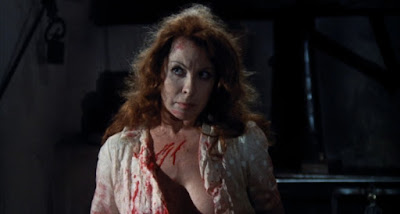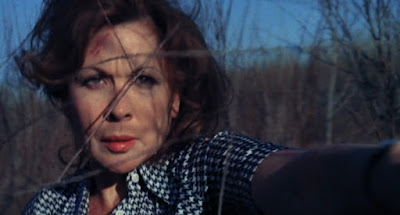“The pleasures I tried to deprive myself of assailed my mind more ardently…” –Madame de Saint-Ange (Marquis de Sade)
After I first watched it, I remember feeling cheated out of the definitive experience of A Candle for the Devil after finding out the version I watched titled It Happened at Nightmare Inn from a bargain DVD box set was heavily cut, omitting the graphic violence and nudity. I still thought it was a pretty sweet film even in its censored form, but of course that’s not the version I wanted for my collection, and so I later ordered off for a DVD-R containing the uncut A Candle for the Devil, with Esperanza Roy’s (from Return of the Evil Dead (1973)) nude scenes thankfully intact. The film has since been released on Blu-ray in 2015 by Scorpion Releasing.
Sisters Marta and Veronica are a couple of murderesses who
run a quaint little boarding house. The immodest behavior of the modern young
female tourists who stay at their boarding house does not jive with Marta’s old-fashioned
belief that decency and purity are better ideals for a young lady. After they
discover one of their guests May (Loreta Tovar) sunbathing on their
roof, much to the amusement of the local men, Marta, with Veronica’s help, very
rudely starts to physically force May out of her house. While Marta is pushing
her, May tumbles down the stairs and crashes into a stained-glass window and instantly
dies. This initially was a tragic accident, until Marta believes she sees a religious
sign in a broken, bloody piece of stained glass and assures her sister that
what just occurred was an act of God. Marta hides the body while Veronica answers
the front door to May’s sister Laura (Judy Geeson), who was supposed to
meet her sister at the boarding house. Laura spends her time trying to get to
the bottom of her sister’s disappearance while murders continue.
Veronica seems to be more in-touch than her sister and questions what is happening but is still always game to take her sister’s side despite the dilemma. She knows what is wrong, but she also knows whose side she’s expected to take; that of blood. What is happening makes her wake up in the night wanting to vomit. She recognizes evil in her own household but is compliant with it. She excuses evil in bad conscience, even deluding herself that the horrible things happening are right by way of mutual belief and a shared bond, but even she knows that something’s eventually got to give before she and her sister are caught.
In the battle between the evocatively scandalous and the religiously righteous, the sweet, mild-mannered Laura (Geeson) falls on neither side and is tolerant of both. Despite some reservations, she does manage to get along well with the judgmental sisters, and she is not offended by the provocations of the younger flirty, sexy female tourists. Not possessing the traits that offend Marta keeps her in the safe zone for a time, until her sleuthing causes her to get too close to the truth. Laura is a kind, even-keel character who mostly doesn’t have a whole lot to do but converse with the sisters, the villagers, and hang around with Eduardo (Winner). Her moment to shine comes in the final scene.
Bautista and Roy are terrific
in their roles and have exquisite chemistry together as killer sisters. The
actors play finely off of one another and do show off a good range of acting
talent from outwardly pious sisters by day to killers of sinful women by night.
Bautista portrays Marta as a much colder killer while Roy gives
Veronica a semblance of guilt and remorse over what is happening. I’m not only convinced
they are sisters, but I’m also convinced they are psychotic. One of the kills I
thought packed an emotional punch, where some serious indignation is felt, is the
scene where they murder a mother, Norma (Blanca Estrada), of a baby essentially
because they wrongfully thought the mother wasn’t married. The moment is
heartbreaking when Norma is killed desperately trying to get her baby back from
Veronica.
A Candle for the Devil is a pretty grim affair that also works as an entertaining horror movie. Its two lead killers are memorable and should be considered more iconic in the history of Spanish horror. After I first watched it, I had that same feeling of enthusiasm that I had after first watching other noteworthy Spanish horror films La residencia (1969) and Tombs of the Blind Dead (1972). The gore is actually comic book level appealing, as an eyeball makes its way into a customer’s, Beatrice’s (Montserrat Julió), food, and a severed head manages to make its way into the basement wine cask, which makes for some fun stuff in this sort of depressing film that hopefully won’t detract too much from the seriousness of it.
© At the Mansion of Madness


















I have the Odeon Region 2 DVD which I suspect is heavily cut. I'll have to think about getting that Blu-Ray release.
ReplyDeleteI thought the movie was subtle psychological horror, and superbly done.
I just finished this film about ten mins ago: I loved it! Some very nice person uploaded an uncut HD copy to YouTube. This movie was almost like a Peter Walker type horror movie but Spanish. All the classic horror exploitation elements were featured and even a downbeat ending.
ReplyDelete